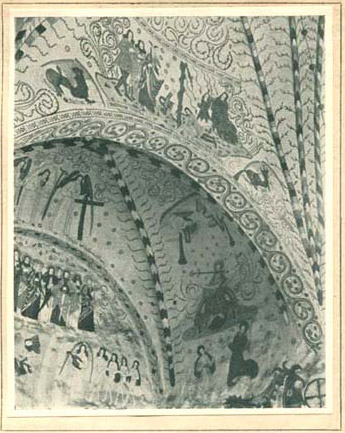
Estate Museum
in Izvara
 |
Nicholas Roerich Estate Museum in Izvara |
|
Page: 6 from 12 |
 "Particularly specific murals were uncovered in Nousiainen in 1880, having been retained under subsequent strata of plastering. Nothing such had yet been revealed in Christian churches. All murals were performed in two shades of colour, namely brick-red and grey. In the same year the murals were again concealed as the designs portrayed were too weird or even repelling to those who would expect in a temple of God a sort of painting exalting religious sentiment. Up in the heights upon the walls, columns, arches and vaults there were partly symmetrical partly fanciful ornamentations being portrayals of enormous birds. Further on, the ornamentations featured various animals, elks, unicorns, vixens, steeds, hounds, wolves and fictitious beings – the mermaids. Apart from those there were depictions of shields and several heads of saints outlined by meticulously painted halos of lustre. These were followed by images alluding, as it were, to arrival of Scandinavian invaders to Finland. Though care was exercised in removing strata of plaster, yet at times the murals suffered, such as in the image of Christ the bigger part of the face went missing. The following section of the murals depicted an ancient long ship with a tall helmsman. Another part displayed two figures of riders about to joust, yet badly visible owing to the damage. One mounted upon an horse and with a miniature dog in front, the other wearing a pointy Lappish hat seated atop a beast with multiple extremities, by whose side there is another beast resembling a wolf. This joust might have been intended as a symbolic depiction of the confrontation between Christianity and paganism. Similar import might have been meant for another peculiar image: on the left a tree with birds nestling therein, an additional bird fluttering above being attacked by two vixens. On the right a huge animal likely to represent an elk or a unicorn with an outstretched tongue. It was through the medium of such animals that Christ used to be represented in the times or yore. Below there is an executioner wielding his weapon above a small human-like figure whose head he is about to sever, in the same manner as he had done to other creatures, whose heads are scattered on the other side of a crucifix. Should one undertake to elucidate the significance of that really peculiar image which came through in such an impaired way in the etching, it becomes possible to suppose that it portrays welfare of those who keep to the Tree of Life, whereas the world of vanity with a fox's cunning lies in wait for souls of men. Following that, Christ is portrayed as the Lord of life and death. Everything is concluded with a depiction of the lot befalling those who are doomed to suffer. |
Next Page |
| Back |